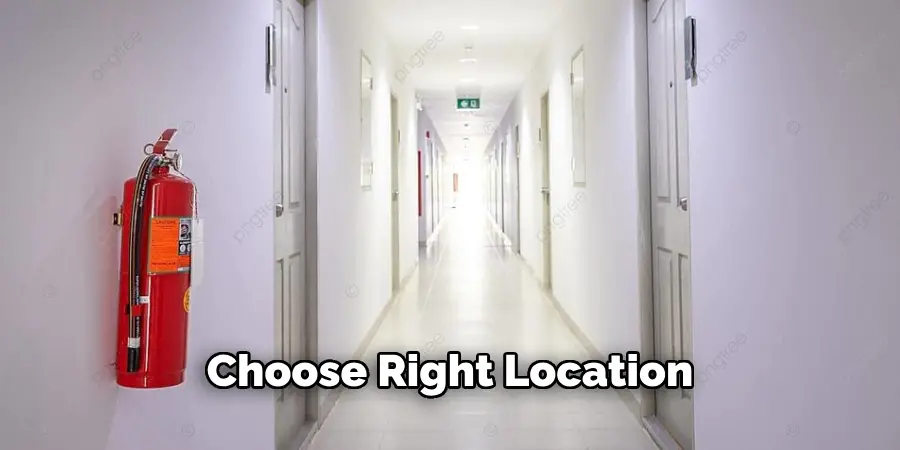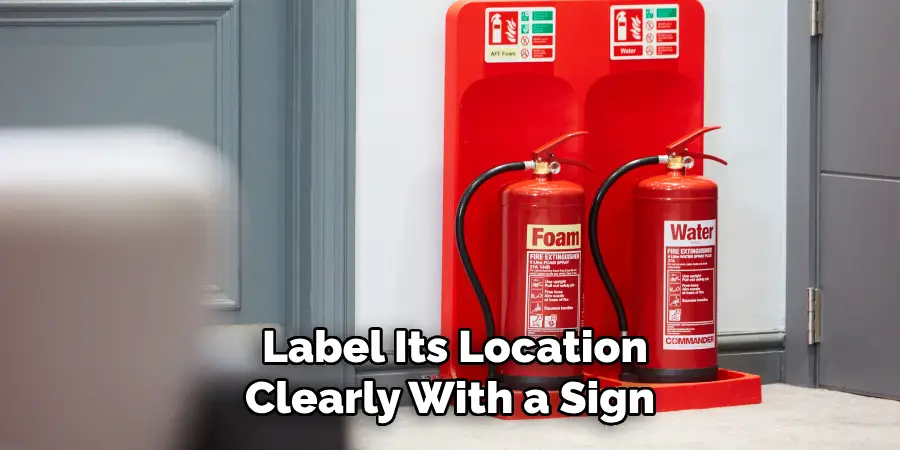Are you worried about your safety at home or at work? Having a fire extinguisher is crucial to protecting yourself and others from potential fire hazards. This guide will walk you through the process of installing one in your desired location.
How to install fire extinguisher is a crucial step in ensuring the safety of your home or workplace. A properly installed fire extinguisher can be the difference between a minor incident and a major disaster. This guide will take you through the necessary steps and considerations for installing a fire extinguisher, including selecting the right location, mounting the equipment securely, and ensuring it’s easily accessible in case of an emergency.

By following these guidelines, you can help protect your property and the people within it from fire dangers.
What Will You Need?
Before you begin the installation process, gathering all the necessary materials and tools is important. Here are some items you will need for installing a fire extinguisher:
- Fire Extinguisher: Make sure you have a fully charged and functioning fire extinguisher that is appropriate for the type of fire hazards in your environment.
- Mounting Bracket: This is used to secure the fire extinguisher in place.
- Screws and Anchors: You will need screws to attach the mounting bracket to the wall or surface and anchors if needed.
- Drill: If you’re mounting on a hard surface, a drill may be necessary to create holes for the screws.
- Screwdriver: You will need a screwdriver to secure the mounting bracket and adjust its position if needed.
- Stud finder: This tool helps you locate the studs in your wall, which provides a sturdy surface for mounting the fire extinguisher.
- Measuring Tape: To ensure proper fire extinguisher placement, it’s important to measure and mark the location before installation.
Once you have all the necessary materials and tools, you can proceed with installing your fire extinguisher.
10 Easy Steps on How to Install Fire Extinguisher
Step 1: Choose the Right Location
Select a visible and easily accessible location for your fire extinguisher. Ideal spots include near exits, hallways, kitchens, or areas where fire hazards are more likely to occur. Ensure the extinguisher is not obstructed and can be quickly reached in an emergency.

Step 2: Use the Stud Finder
Using a stud finder, locate the studs in your wall. Studs are vertical wooden or metal supports inside your walls that provide a sturdy surface for mounting heavy objects like fire extinguishers. Slide the stud finder along the wall slowly until it indicates the edge of a stud. Mark the stud’s edges with a pencil, then locate the other edge and mark it as well. This will help you determine the exact center of the stud. Ensure you mark the stud location at the height you plan to mount your fire extinguisher.
Step 3: Mark the Mounting Points
With the center of the stud identified, hold the mounting bracket against the wall at the desired height, ensuring it’s level. Use a pencil to mark the locations of the screw holes on the wall through the bracket’s holes. This step ensures that once you start drilling, the holes will be in the correct positions for securing the bracket firmly.
Step 4: Drill Pilot Holes
If you are drilling into a stud, use a drill bit that is slightly smaller than the screws you will be using. Drill pilot holes at the marked points to make it easier to insert the screws and prevent the wall from cracking. If you are mounting on drywall and not directly into a stud, you must use wall anchors. Drill holes according to the specifications for your wall anchors.
Step 5: Install Wall Anchors (If Needed)
If your fire extinguisher needs to be mounted on drywall without the support of a stud, insert wall anchors into the drilled holes. Tap them lightly with a hammer until they are flush with the wall surface. Wall anchors provide the necessary support to securely hold the fire extinguisher’s weight.
Step 6: Attach the Mounting Bracket
Align the mounting bracket with the pilot holes or wall anchors. Using a screwdriver, drive the screws through the bracket into the pilot holes or anchors, securing the bracket to the wall. Ensure the bracket is firmly attached and does not wiggle or move.
Step 7: Mount the Fire Extinguisher
Once the mounting bracket is securely attached to the wall, it’s time to mount the fire extinguisher. Lift the fire extinguisher and line it up with the bracket. Most fire extinguishers will simply hook onto or clip into the mounting bracket. Ensure the extinguisher faces forward with the handle and nozzle easily accessible. Ensure that the extinguisher is securely locked in place and cannot be easily knocked off or dislodged.
Step 8: Check for Secure Installation
With the fire extinguisher now mounted, give it a gentle tug and shake to confirm that it is securely attached and will not come loose. The extinguisher must remain firmly in position, even if it is bumped or jostled during normal activities. The mounting bracket should withstand the extinguisher’s weight without any signs of shifting or wavering.
Step 9: Label and Inform
Once the fire extinguisher is in place, label its location clearly with a sign. This is particularly important in workplaces or public areas where others may need to locate it quickly in an emergency.

Ensure that everyone in the area knows the location and understands how to use the fire extinguisher. Conduct regular training and refreshers on fire safety procedures, emphasizing the importance of understanding how to operate the extinguisher.
Step 10: Regular Maintenance and Inspections
Installing a fire extinguisher is only the first step; regular maintenance and inspections are crucial to ensuring it remains functional. Check the extinguisher’s pressure gauge monthly to confirm it is fully charged. Inspect the pin, nozzle, and other components for any signs of wear or damage. Schedule annual professional inspections as recommended by the manufacturer or local fire codes. Keep a record of all maintenance and inspections to ensure the extinguisher is always ready for use in case of an emergency.
By following these steps, you will have successfully installed your fire extinguisher in a safe and accessible location. Regularly check its condition and ensure that everyone knows its location and how to use it, so you are well-prepared in the event of a fire.
5 Additional Tips and Tricks
- Mount at the Correct Height: Typically, the fire extinguisher handle should be about 3 to 5 feet above the ground. This height ensures it can be reached quickly in case of an emergency.
- Ensure Clear Visibility: The fire extinguisher should be in plain view, with no obstructions blocking it. Additionally, consider placing signage above the extinguisher to indicate its location clearly.
- Secure Mounting Brackets: Use the brackets provided with the fire extinguisher to securely mount it to the wall. Make sure the mounting is strong and stable to prevent the extinguisher from falling or being easily dislodged.
- Keep Extinguishers in Multiple Locations: Having multiple fire extinguishers in different locations throughout your home or workplace is a good idea. This ensures easy access and coverage in case a fire breaks out in different areas.
- Check Extinguishers Regularly: Like any other safety equipment, fire extinguishers require regular maintenance. Check the pressure gauge and inspect for any signs of damage or wear and tear. If necessary, get them serviced or replaced to ensure they are in proper working condition.

With these additional tips and tricks, you can ensure that your fire extinguisher is easily accessible, secure, and well-maintained for any emergency situation.
5 Things You Should Avoid
- Mounting in Hard-to-Reach Areas: Avoid installing fire extinguishers in places that are difficult to access, such as high shelves or behind furniture. In an emergency, you need to be able to grab the extinguisher quickly and easily.
- Ignoring Building Codes and Regulations: When installing your fire extinguisher, make sure to follow local building codes and fire safety regulations. Failure to comply with these can lead to safety hazards and potential fines.
- Placing Extinguishers Near Heat Sources: Never install fire extinguishers near stoves, heaters, or any other heat source. High temperatures can damage the extinguisher or cause it to malfunction when you need it the most.
- Using Improper Mounting Hardware: Do not use makeshift or inappropriate mounting hardware. Always use the brackets and screws provided by the manufacturer to ensure the extinguisher is securely fastened to the wall.
- Neglecting Regular Maintenance: Installing a fire extinguisher is not a one-time task. Avoid neglecting regular checks and maintenance. Ensure that the extinguisher is installed properly and inspected periodically to maintain its effectiveness.
By steering clear of these common mistakes, you can ensure that your fire extinguisher is installed correctly and ready for use in the event of a fire emergency.

Conclusion
How to install fire extinguisher correctly is crucial for ensuring its effectiveness in an emergency.
Following the steps and guidelines, you can safeguard your home or workplace against fire hazards. Start by choosing the right type and size of extinguisher for your space’s specific needs. Mount it at an accessible height and in a visible location, using the correct hardware to secure it firmly. Avoid placing it near heat sources and ensure it is easily reachable in case of an emergency. Lastly, regular maintenance checks are essential to keep the extinguisher in optimal working condition.
Adhering to these best practices enhances your safety and ensures compliance with local fire safety regulations. Make fire safety a priority by properly installing and maintaining your fire extinguisher, which will give you peace of mind and preparedness.
